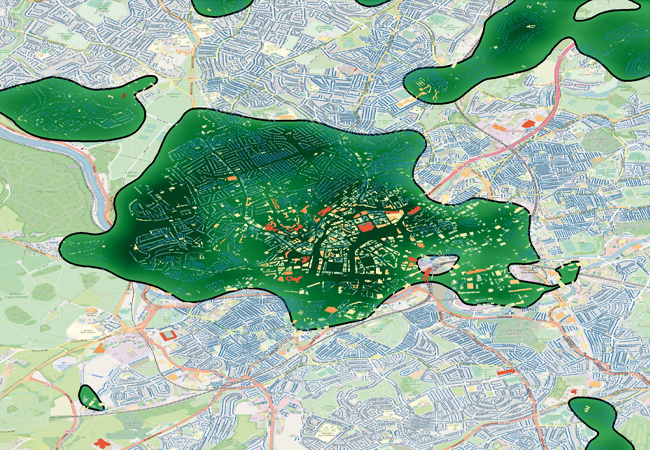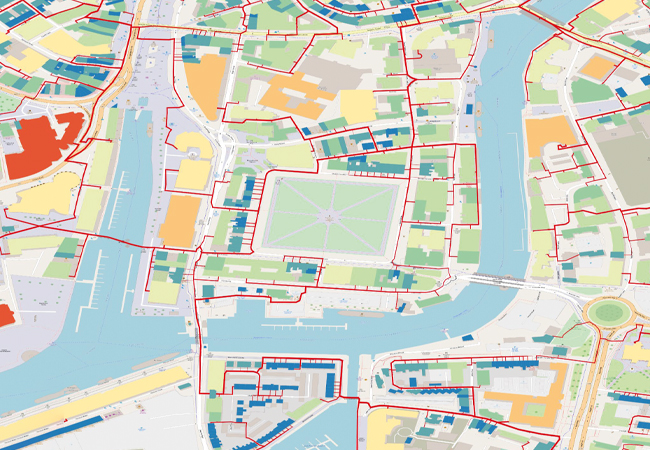
Figure 1: Indicative heat-zoning output undertaken on behalf of Bristol City Council. The green zones reflect areas of the city where heat networks are theoretically the lowest-cost option to achieve heat decarbonisation
On 8 October 2021, the government published a consultation on proposals for heat network zoning in England. Heat networks transfer heat (hot water/and or cooling) from a central source or sources to buildings, including dwellings, public buildings, and business and commercial premises. As such, they are able to unlock the use of large-scale recovered waste heat from industry, rivers and mines.
The heat zoning proposals envisage central and local government working with industry and local stakeholders to identify and designate areas within which heat networks are the lowest-cost low carbon solution for decarbonising heating. If adopted, certain buildings within declared zones could be mandated to connect to a heat network.
The proposals are underpinned by three CIBSE documents– CP1: Heat networks: Code of practice for the UK (2020); Design guide: Heat networks; and Guidance note: Domestic hot-water temperatures from instantaneous HIUs.
‘A lot of things are coming together on the heat networks front,’ says Phil Jones, an independent energy consultant.
The consultation is the government’s first step in addressing barriers to the implementation of heat networks in England. It says there is significant potential for the number and scale of networks to increase dramatically by central and local government working together with industry to designate areas in which networks can be deployed as a low-cost solution for decarbonising heating.
Heat networks are sometimes characterised by high upfront capital costs with long payback periods. In addition, the risk of heat loads not connecting to networks can create uncertainty, which government says hampers investment. Zoning is intended to tackle this by providing investors with connection assurance, because it will be mandatory for key buildings to connect to networks, as long as it is cost-effective (and practical) to do so.
To ensure an established customer base for heat, all new buildings, large public sector and large non-domestic buildings, and communally heated domestic premises ‘would be required to connect to a heat network within a prescribed timeframe’. Jones says it’s ‘about providing a demand so that a heat network operator can be certain that at least the mandated buildings will connect, leading to a viable project’.
Developing a heat network also requires coordination and agreement between the developer and a range of parties, which can be challenging and deter investors. Zoning tackles this by taking a central strategic approach to heat decarbonisation and giving the government the power to designate where zones are, and which buildings must connect.
The consultation is the government’s first in a project that is intended to take place over several years. It is seeking views on a number of issues, including:
- The methodology used for identifying and designating heat network zones
- Roles and responsibilities of different parties involved in the zoning process
- The requirement of certain buildings within zones to connect to a heat network, with an exemption process to avoid sub-optimal outcomes
- Requirements on certain parties to provide information to support identification and designation of zones
- Whether zones should meet a low carbon requirement
- Enforcement, monitoring and reporting regimes.
Customers for heat will be protected with the ‘introduction of a separate regulatory framework for the sector’. Ofgem has been appointed as the heat network regulator, with responsibility to enforce sector-specific protections on pricing and quality of service once legislation is in place. Heat networks currently provide about 2% of UK heat demand. The impact assessment accompanying this consultation estimates that the zoning proposals will enable an additional 31TWh of heat to be deployed in the period to 2050, which is about 7% of UK heat demand.
Jones says the heat-zoning document will drive use of CIBSE publication CP1, which sets out minimum standards for networks, as well as checklists for compliance.
To accompany CP1, CIBSE has published Design guide: Heat networks. Authored by Chris Parsloe, this document is written for those with previous experience of closed, recirculating commercial heating and chilled-water systems. The guide focuses on hydronic issues: how to control flows and temperatures around the network to get the best carbon savings from central heat sources.
Both CP1 and the heat networks design guide reference a third document more recently published by CIBSE (August 2021), Guidance note: Domestic hot-water temperatures from instantaneous HIUs. This summarises current hot-water standards and legislation, clarifies where these are relevant to low-volume instantaneous heat interface units (HIUs), and sets out a design approach that addresses all key temperature requirements. It also explains that, if you are not storing the heated water, there is very little chance of legionella being present.
The significance of the guidance note is that it enables a reduction in the temperature of a heat network, where instantaneous HIUs are used to connect to the system. ‘What that does, is allow heat networks to be designed at 60°C, rather than 80°C or 90°C, so we’ve effectively reduced hot-water temperatures and, therefore, heat network temperatures,’ explains Jones.

Figure 2: Heat-network map undertaken on behalf of Bristol City Council
Lower-temperature heat networks have lower heat losses and are more compatible with renewable technologies, such as heat pumps, all of which serve to improve the economic viability of a heat network.
The three CIBSE documents work together as a suite for heat network designers. ‘The guidance note effectively reduces heat network temperatures; the design guide has details on system design, pipe sizing and storage requirements; and the code of practice draws all of this together by specifying minimum standards,’ says Jones.
In addition, BESA has been running a UK standard for HIUs. This will enable the performance of HIUs to be evaluated within the context of typical UK operating conditions, so developers can evaluate the performance of a specific HIU against design requirements. It is now a requirement of CP1 to use tested HIUs.
Zoning is the first step in the government moving towards regulating the heat network sector, which could eventually see the supply of low carbon heat delivered as a utility.
CIBSE head of sustainability Julie Godefroy acknowledges the potential role of heat networks in heat decarbonisation, particularly for hard-to-treat properties that have few other options.
‘However, support to networks cannot be on principles alone and has to be related to outcomes,’ she says. In its response to the consultation proposals Godefroy says CIBSE will be looking at what requirements will be in place for networks to benefit from heat zoning obligations. ‘These should be on condition of network energy efficiency and low running costs,’ says Godefroy. There should also be processes should actual performance in use not meet the intent at investment and design stages.’
Godefroy adds that many properties could have lower-carbon options than heat networks and that these should not be prevented.
CIBSE would also like more proposals on existing networks, many of which operate on gas with no decarbonisation plan in place, she says.
The consultation closes on 19 November 2021. Contact JGodefroy@cibse.org if you would like to contribute to CIBSE’s response. To attend a CIBSE webinar on the design guide and DHW Guide on 11 November, visit CIBSE’s Grow Your Knowledge.




